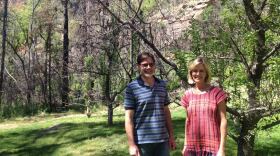Smoke is a complicated substance. Most people who live in or near western forests have a good feel for how it affects people. But what's less well known is that it affects plants, too.
Experiments have shown that trees exposed to smoke respond as most people do: they try to limit their exposure. Trees do this by shutting the stomata in their leaves - the small pores through which they respire.
That reduces their leaves' exposure to potentially toxic compounds - but it also means that trees exposed to smoke for long periods have reduced rates of photosynthesis and growth.
For seeds, the story is different. Experiments in fire-prone ecosystems from Australia to Arizona have shown that smoke helps some kinds of seeds germinate. Biologists aren't sure why, though they think that some compounds in smoke may serve as a chemical signal or help seeds take in water.
Greenhouse experiments at Northern Arizona University have shown that some of the seeds most stimulated by smoke are light-loving species such as penstemons that can thrive after fire. It's been tough, though, to replicate greenhouse results in the field.
It's likely that exposure to smoke is only one of an array of factors - such as changed availability of light and water - that regulates which species do well after a fire has swept through. But it's good to keep in mind that the smoke that we often find irritating may play a positive role in how forest ecosystems recover after a fire.








